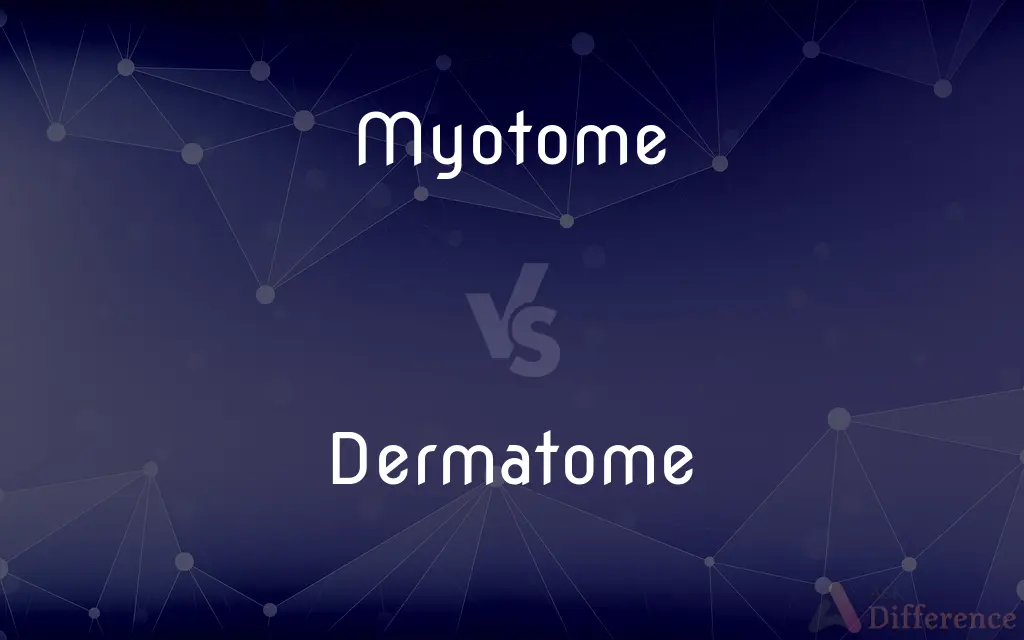Myotome vs. Dermatome — What's the Difference?
By Maham Liaqat & Urooj Arif — Updated on March 19, 2024
A myotome is a group of muscles innervated by a specific spinal nerve, while a dermatome is an area of skin innervated by a specific spinal nerve.

Difference Between Myotome and Dermatome
Table of Contents
ADVERTISEMENT
Key Differences
Myotomes are the result of the segmentation of the mesoderm in the developing embryo, which gives rise to skeletal muscles. Each myotome is innervated by a single spinal nerve root, and it controls the muscles within that specific segment. Dermatomes, on the other hand, are areas of skin that receive sensory innervation from a single spinal nerve root. The concept of dermatomes is essential in diagnosing and understanding the spread of certain diseases, as well as in the administration of regional anesthesia.
The study of myotomes and dermatomes is interrelated; both are used to map the body's neurological organization. While myotomes are more about motor function, indicating which muscles are controlled by which spinal nerves, dermatomes focus on sensory perception, delineating which spinal nerves are responsible for sensory information in specific areas of the skin.
In clinical practice, understanding both myotomes and dermatomes allows healthcare professionals to more accurately diagnose and treat conditions related to the nervous system. For instance, a herniated disc might compress a nerve root, affecting both the muscle function (myotome) and sensation (dermatome) of a specific body region.
The evolutionary significance of myotomes and dermatomes lies in their origins from the segmented structure of early vertebrates. This segmentation allowed for more sophisticated movement and sensory perception, contributing to the complexity of vertebrate bodies. While myotomes facilitated the development of complex muscle groups for movement, dermatomes allowed for the detailed sensory mapping of the skin.
Comparison Chart
Definition
Group of muscles innervated by a specific spinal nerve.
Area of skin innervated by a specific spinal nerve.
ADVERTISEMENT
Function
Related to muscle movement and strength.
Related to sensory perception in the skin.
Clinical Importance
Used to localize neurological lesions or nerve damage.
Essential in diagnosing diseases and administering regional anesthesia.
Example
C5 myotome controls the deltoid muscle.
T4 dermatome corresponds to the skin over the nipples.
Evolutionary Significance
Originated from the segmented mesoderm in embryos, facilitating complex movements.
Resulted from the need for detailed sensory mapping of the skin in vertebrates.
Compare with Definitions
Myotome
A segmental muscle group innervated by a specific spinal nerve.
The biceps brachii muscle is part of the C5-C6 myotomes.
Dermatome
A skin area supplied by sensory fibers of a single spinal nerve.
The area of the chest and upper back corresponds to the T4 dermatome.
Myotome
Specific movements are tested to assess myotome function.
Elbow extension tests the C7 myotome.
Dermatome
Used to identify patterns of sensory loss or pathology.
Herpes zoster often affects a single dermatome.
Myotome
Helps in localizing spinal nerve or root injuries.
Weakness in hip flexion might indicate a problem with the L2 myotome.
Dermatome
Guides the administration of regional blocks.
Epidural anesthesia during childbirth targets specific lumbar dermatomes.
Myotome
Targeted exercises can strengthen specific myotomes.
Shoulder abduction exercises for the C5 myotome after injury.
Dermatome
Highlights the importance of sensory precision in survival.
Dermatomes allow for localized sensation and response to environmental stimuli.
Myotome
Reflects the segmented organization of the vertebrate body.
Myotomes are derived from somites in the developing embryo.
Dermatome
Dermatome mapping is used in neurological exams.
Testing for numbness or tingling along the S1 dermatome.
Myotome
A myotome is the group of muscles that a single spinal nerve innervates. Similarly a dermatome is an area of skin that a single nerve innervates.
Dermatome
(Anatomy) An area of skin innervated by sensory fibers from a single spinal nerve.
Myotome
A segmental mass of mesoderm in a vertebrate embryo that differentiates into skeletal muscle.
Dermatome
(Medicine) An instrument used in cutting thin slices of the skin, as for skin grafts.
Myotome
A muscle or group of muscles derived from one somite and innervated by a single segment of a spinal nerve.
Dermatome
(Embryology) The part of a mesodermal somite from which the dermis develops.
Myotome
A knife for dividing muscle during surgery.
Dermatome
An instrument used surgically to remove a thin slice of skin for grafting
Myotome
In vertebrate embryonic development, a group of tissues formed from any particular one of the somites that develop into the body wall muscle. myomere.
Dermatome
An area of skin which is innervated by afferent nerve fibers coming to a single posterior spinal root.
Myotome
In neurology, a group of muscles innervated from a particular spinal segment; the division of innervation reflects the embryology of the various somites.
Dermatome
The cutis plate.
Myotome
A surgical instrument for performing myotomy.
Dermatome
A surgical instrument used to cut very thin slices of skin
Myotome
A muscular segment; one of the zones into which the muscles of the trunk, especially in fishes, are divided; a myocomma.
Common Curiosities
Can myotome and dermatome mappings vary between individuals?
While there is a general pattern, there can be slight variations in myotome and dermatome mappings between individuals due to anatomical diversity.
What is the significance of testing myotomes in a clinical setting?
Testing myotomes helps in diagnosing and localizing neurological disorders or injuries affecting motor function, facilitating targeted treatments.
How does an injury to a spinal nerve affect both myotomes and dermatomes?
An injury to a spinal nerve can impair both the motor function of the muscles innervated by that nerve (myotome) and the sensory perception of the skin area it innervates (dermatome).
Can myotomes and dermatomes overlap in their functions or areas?
While myotomes and dermatomes may cover similar body regions, their functions are distinct: myotomes relate to muscle movement, and dermatomes to skin sensation.
How do dermatomes aid in understanding the spread of diseases like shingles?
Since shingles typically follows the path of a single dermatome, recognizing the affected dermatome can help diagnose the condition and predict its spread.
What distinguishes a myotome from a dermatome in terms of their development?
Myotomes develop from the mesodermal somites in the embryo, leading to skeletal muscles, whereas dermatomes develop from the ectoderm, contributing to the sensory innervation of the skin.
In what way do dermatomes play a role in surgical planning?
Surgeons consider dermatome maps to minimize sensory loss or nerve damage during procedures, ensuring incisions avoid major dermatome pathways when possible.
What is the clinical significance of overlapping dermatomes?
Overlapping dermatomes ensure there are no gaps in sensory coverage, which is crucial for detecting and responding to injuries or environmental hazards.
Why is knowledge of dermatomes important for administering anesthesia?
Understanding dermatomes allows anesthesiologists to effectively block sensation in specific body areas during surgeries or procedures like childbirth.
Can diseases or conditions affect myotomes and dermatomes differently?
Yes, certain conditions may predominantly affect motor or sensory functions, thus impacting myotomes or dermatomes more severely, respectively.
How can myotome testing be used in physical therapy?
Physical therapists use myotome testing to assess and improve muscle strength and motor function in patients recovering from nerve injuries or spinal conditions.
Why might a patient experience numbness in a dermatomal pattern?
Numbness following a dermatomal pattern usually indicates a nerve root compression or damage at the corresponding spinal level, often due to herniated discs or spinal stenosis.
How does the concept of myotomes enhance understanding of evolutionary biology?
The study of myotomes reveals insights into the evolutionary adaptations of vertebrates, particularly in the development of complex musculature for varied movements.
What role do myotomes and dermatomes play in reflex testing?
Reflex tests often target specific myotomes, and the sensory response involves dermatomes, helping diagnose the integrity of spinal cord segments and peripheral nerves.
How are myotomes identified during a neurological examination?
Neurologists assess myotomes by asking patients to perform specific movements, such as knee extension or finger flexion, to evaluate muscle strength and nerve function.
Share Your Discovery

Previous Comparison
Til vs. Till
Next Comparison
Esports vs. SportsAuthor Spotlight
Written by
Maham LiaqatCo-written by
Urooj ArifUrooj is a skilled content writer at Ask Difference, known for her exceptional ability to simplify complex topics into engaging and informative content. With a passion for research and a flair for clear, concise writing, she consistently delivers articles that resonate with our diverse audience.















































